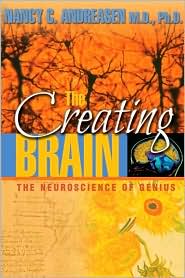 What happens in our brains when we create? And what happens in the brains of extraordinarily creative people—the Michelangelos, the Leonardos, the Mozarts, the Einsteins—when they exercise their creative genius? Is there a link between creative genius and mental illness? What are the factors—biological and environmental—that come together to create a new creative genius?
What happens in our brains when we create? And what happens in the brains of extraordinarily creative people—the Michelangelos, the Leonardos, the Mozarts, the Einsteins—when they exercise their creative genius? Is there a link between creative genius and mental illness? What are the factors—biological and environmental—that come together to create a new creative genius?
These are the questions that Nancy Andreasen explores in The Creating Brain: The Neuroscience of Genius. Andreasen focuses her attention on extraordinary creativity, the creativity exhibited by people recognized for their creative successes. Andreasen holds both a Ph.D. in Renaissance English Literature, and an M.D. (she is the Andrew H. Woods Chair of Psychiatry and Director of the Mental Health Clinical Research Center at the University of Iowa Hospitals and Clinics and an adjunct professor of psychiatry and neurology and director of the MIND Institute at the University of New Mexico), so she brings a dual perspective to her study: The arts and humanities view of the literature scholar, and the neuropsychiatric view of the physician.
We have been learning much about how our brains work, thanks to new technology such as Functional Magnetic Resonance Imaging (fMRI) and single-photon emission computerized tomography (SPECT), which let us look at what areas of the brain are active during different tasks. However, we haven’t had many opportunities to look inside brain of a creative genius while they’re creating. So researchers have been forced to rely on case studies, journals, and occasionally, an interview of various creative geniuses.
But these sources do give us some fascinating insights. Andreasen once sat next to playwright Neil Simon on an airplane, and had a long conversation with him about his creative process. Simon told Andreasen, “I slip into a state that is apart from reality.” Andreasen writes, “In psychiatric terms, this could be described as a ‘dissociative state.’ That is, the person in a sense mentally separates himself from his surroundings and metaphorically ‘goes to another place.’” She describes this as “a place where words, thoughts, and ideas float freely, collide, and ultimately coalesce.”
Andreasen cites the writings of several creative individuals—Wolfgang Amadeus Mozart, Peter Ilych Tchaikovsky, Henri Poincaré, Friedrich Kekulé, and Stephen Spender—who also describe their periods of intense creativity in similar terms.
For example, Mozart said of his creative states that “All this inventing, this producing, takes place in a pleasing lively dream.” Tchaikovsky said that he went into “a somnambulistic state,” in which ideas came to him rapidly.
What of the mythical connection between genius and insanity? Andreasen surveys the literature, and finds that there may be a connection. For example, she conducted a survey of participants in the Iowa Writers Workshop with a working hypothesis that writers would have a significantly increased rate of schizophrenia in their family members. What she found was that the writers themselves had histories of mood disorders, such as bipolar illness or depression.
From her research, and her delving into the literature, Andreasen believes that there may be different mental disorders associated with different types of creativity. She believes that there is a strong connection between mood disorders and artistic creativity, while types of creativity characterized flashes of insight, or by making connections between wildly disparate ideas, may be more closely associated with illnesses such as schizophrenia.
The emphasis of the book is on creative genius, and theories about how it operates. However, Andreasen does offer some practical ideas on what everyone can do to cultivate their own “ordinary creativity.” She advises us to explore unfamiliar areas of knowledge in depth, practicing meditation or “just thinking” daily, observing and describing things around us in detail, and flexing our imaginative muscles.
“Creativity arises from the brain,” she writes. “Its essence is the ability to perceive and think in original and novel ways. Its seeds may be planted by nature, but nurture helps it germinate, flower, and grow. Nature cannot be easily changed. But nurture is under our own control.”
Andreasen’s website is nancyandreasen.com.
The Creating Brain: The Neuroscience of Genius, by Nancy C. Andreasen, M.D., Ph.D.
- ISBN 1932594078
- Dana Press, 2005
- Hardcover, 197 pages

